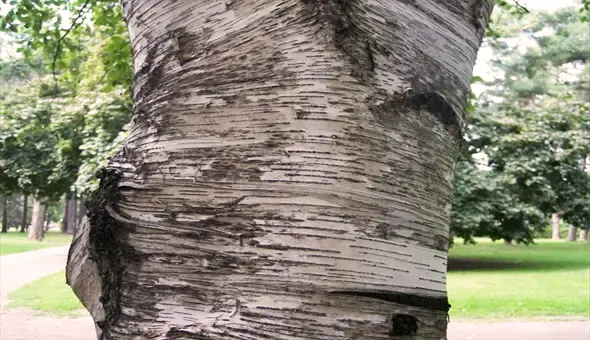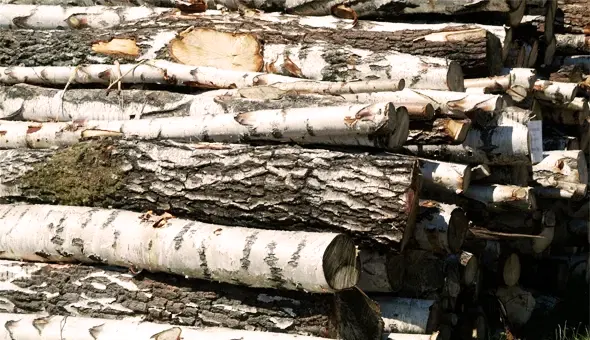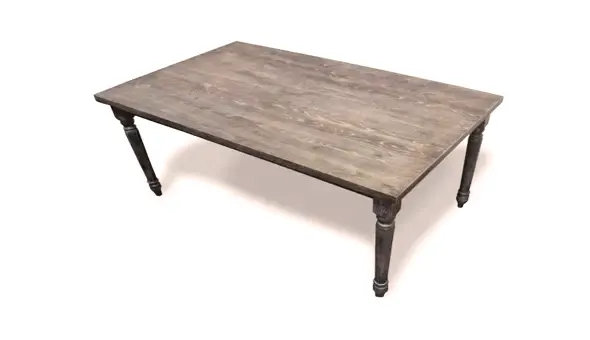Gray Birch Lumber
- July 27, 2023
- 0 comment
Gray Birch (Betula populifolia) is a versatile hardwood species highly regarded in the lumber industry for its wide range of applications. Renowned for its elegant and unique appearance, Gray Birch features a delightful blend of light grayish-brown hues, occasionally adorned with dark streaks and knots.

The wood’s subtle grain patterns and straight, even texture further enhance its appeal, making it a popular choice for both interior and exterior projects. Its moderate availability at reasonable prices makes it accessible to woodworkers and builders alike. This fast-growing tree species primarily thrives in the eastern regions of North America.
With an average height ranging from 40 to 70 feet and a diameter of 1 to 2 feet, Gray Birch yields lumber of considerable size. Its average dried weight of 30 to 38 lbs/ft3 and specific gravity of 0.48 to 0.61 contribute to its favorable strength-to-weight ratio. The wood boasts a Janka hardness of 910 lbf, making it sufficiently durable for various applications. Gray Birch’s impressive properties extend to its modulus of rupture at 15,200 psi, elastic modulus at 1.60 Mpsi, and crushing strength at 7,700 psi, all of which contribute to its excellent workability and suitability for a wide array of woodworking projects.
| Property | Description |
|---|---|
| Common Name(s) | Gray Birch |
| Scientific Name | Betula populifolia |
| Distribution | Eastern North America |
| Tree Size | Height: 40-70 feet (12-21 meters), Diameter: 1-2 feet (0.3-0.6 meters) |
| Avg. Dried Weight | 30-38 lbs/ft3 (480-610 kg/m3) |
| Specific Gravity | 0.48-0.61 |
| Janka Hardness | 910 lbf (4,050 N) |
| Modulus of Rupture | 15,200 psi (105 MPa) |
| Elastic Modulus | 1.60 Mpsi (11.0 GPa) |
| Crushing Strength | 7,700 psi (53 MPa) |
| Shrinkage | Radial: 4.5%, Tangential: 7.7%, Volumetric: 12.4% |
Characteristics
Color/Appearance
Gray Birch presents a visually captivating color palette, ranging from light gray to pale brown, often showcasing subtle yet charming dark streaks and occasional knots. Its sapwood, in contrast to the heartwood, features a distinct light hue, allowing for easy differentiation between the two. This delightful combination of colors adds character and uniqueness to the wood, making it an appealing choice for various aesthetic applications.


Grain/Texture
Gray Birch boasts a straight and even wood grain that exudes a sense of elegance and simplicity. With a fine to medium texture, the wood’s surface offers a smooth and uniform appearance, which makes it a delight to work with during woodworking projects. Its consistent texture and lack of irregularities contribute to the ease of machining, resulting in clean and precise finishes.
Rot Resistance
While Gray Birch exhibits commendable strength and durability, it lacks natural resistance to decay and fungal attacks. To prolong its lifespan and ensure its suitability for outdoor applications, appropriate treatment or finishing is recommended to enhance its rot resistance and protect it from environmental elements.
Workability
Renowned for its workability, Gray Birch allows craftsmen to easily shape and manipulate it using hand and power tools. Its cooperative nature during cutting, routing, and carving processes makes it a favored choice for woodworking projects. However, when it comes to gluing, extra care is advised due to its closed pores, which might hinder optimal adhesive penetration.

Odor
One of the advantages of working with Gray Birch is its lack of a distinctive odor. This property makes it ideal for certain woodworking projects where avoiding strong scents is desirable.
Allergies/Toxicity
Gray Birch is generally considered safe to work with, as there are no significant reports of allergic reactions associated with this wood. Nevertheless, it is always prudent to follow standard safety measures and use protective gear while handling any woodworking material.
Pricing/Availability
Gray Birch lumber is commonly found at moderate prices, making it accessible to a wide range of woodworkers and builders. Its availability is often dependent on the regions where the tree is abundant, ensuring a steady supply for various woodworking needs.
Sustainability
As a fast-growing species, Gray Birch stands out for its potential sustainability. With proper management practices and responsible harvesting, it can be an environmentally friendly choice for woodworking projects. To support sustainable practices, it is recommended to source Gray Birch lumber from reputable suppliers or certified forests.

Common Uses
Gray Birch finds extensive application in the realm of woodworking, commonly employed in crafting furniture, cabinetry, and interior trim due to its appealing appearance and ease of workability. Its graceful and even texture makes it an excellent choice for flooring, providing a smooth surface with a touch of natural elegance. Additionally, Gray Birch’s fine qualities are appreciated in the art of turnery, where it can be skillfully shaped into various artistic and functional objects.
Frequently Asked Questions
- Is Gray Birch suitable for outdoor projects?
While Gray Birch is not naturally rot-resistant, it can still be used for outdoor projects if appropriately treated with a suitable finish or preservative. - How does Gray Birch compare to other birch species?
Gray Birch is generally less dense and harder than other birch species like Yellow Birch or Paper Birch. - Can I stain Gray Birch easily?
Yes, Gray Birch takes stains and finishes well, allowing you to achieve various colors and appearances. - Does Gray Birch have any unique properties?
Gray Birch is sometimes referred to as White Birch due to its similar appearance to Paper Birch, but it is a distinct species. - Is Gray Birch difficult to work with?
Gray Birch is generally considered easy to work with, and its fine, even texture makes it ideal for various woodworking projects.
We’re eager to hear from you! Feel free to share your personal experiences and thoughts about the Gray Birch Lumber in the comments section below. Your insights could be a valuable resource, aiding fellow nature enthusiasts in making informed decisions and appreciating the unique qualities of this Lumber!










Leave your comment